Assembly of the type II secretion system such as found in Vibrio cholerae depends on the novel Pilotin AspS
- PMID: 23326233
- PMCID: PMC3542185
- DOI: 10.1371/journal.ppat.1003117
Assembly of the type II secretion system such as found in Vibrio cholerae depends on the novel Pilotin AspS
Abstract
The Type II Secretion System (T2SS) is a molecular machine that drives the secretion of fully-folded protein substrates across the bacterial outer membrane. A key element in the machinery is the secretin: an integral, multimeric outer membrane protein that forms the secretion pore. We show that three distinct forms of T2SSs can be distinguished based on the sequence characteristics of their secretin pores. Detailed comparative analysis of two of these, the Klebsiella-type and Vibrio-type, showed them to be further distinguished by the pilotin that mediates their transport and assembly into the outer membrane. We have determined the crystal structure of the novel pilotin AspS from Vibrio cholerae, demonstrating convergent evolution wherein AspS is functionally equivalent and yet structurally unrelated to the pilotins found in Klebsiella and other bacteria. AspS binds to a specific targeting sequence in the Vibrio-type secretins, enhances the kinetics of secretin assembly, and homologs of AspS are found in all species of Vibrio as well those few strains of Escherichia and Shigella that have acquired a Vibrio-type T2SS.
Conflict of interest statement
The authors have declared that no competing interests exist.
Figures
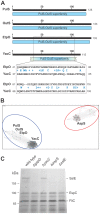

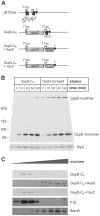
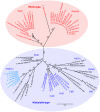
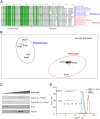
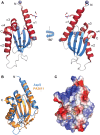

Similar articles
-
Scaffolding Protein GspB/OutB Facilitates Assembly of the Dickeya dadantii Type 2 Secretion System by Anchoring the Outer Membrane Secretin Pore to the Inner Membrane and to the Peptidoglycan Cell Wall.mBio. 2022 Jun 28;13(3):e0025322. doi: 10.1128/mbio.00253-22. Epub 2022 May 12. mBio. 2022. PMID: 35546537 Free PMC article.
-
Structural and functional insights into the pilotin-secretin complex of the type II secretion system.PLoS Pathog. 2012 Feb;8(2):e1002531. doi: 10.1371/journal.ppat.1002531. Epub 2012 Feb 9. PLoS Pathog. 2012. PMID: 22346756 Free PMC article.
-
Structure and assembly of pilotin-dependent and -independent secretins of the type II secretion system.PLoS Pathog. 2019 May 13;15(5):e1007731. doi: 10.1371/journal.ppat.1007731. eCollection 2019 May. PLoS Pathog. 2019. PMID: 31083688 Free PMC article.
-
Bacterial secretins: Mechanisms of assembly and membrane targeting.Protein Sci. 2020 Apr;29(4):893-904. doi: 10.1002/pro.3835. Epub 2020 Feb 19. Protein Sci. 2020. PMID: 32020694 Free PMC article. Review.
-
Secretins revealed: structural insights into the giant gated outer membrane portals of bacteria.Curr Opin Struct Biol. 2018 Aug;51:61-72. doi: 10.1016/j.sbi.2018.02.008. Epub 2018 Mar 23. Curr Opin Struct Biol. 2018. PMID: 29579693 Review.
Cited by
-
Crystal structure of the pilotin from the enterohemorrhagic Escherichia coli type II secretion system.J Struct Biol. 2013 May;182(2):186-91. doi: 10.1016/j.jsb.2013.02.013. Epub 2013 Feb 28. J Struct Biol. 2013. PMID: 23458689 Free PMC article.
-
Differential Regulation of the Surface-Exposed and Secreted SslE Lipoprotein in Extraintestinal Pathogenic Escherichia coli.PLoS One. 2016 Sep 6;11(9):e0162391. doi: 10.1371/journal.pone.0162391. eCollection 2016. PLoS One. 2016. PMID: 27598999 Free PMC article.
-
Core architecture of a bacterial type II secretion system.Nat Commun. 2019 Nov 28;10(1):5437. doi: 10.1038/s41467-019-13301-3. Nat Commun. 2019. PMID: 31780649 Free PMC article.
-
Multiple Structures Disclose the Secretins' Secrets.J Bacteriol. 2018 Feb 7;200(5):e00702-17. doi: 10.1128/JB.00702-17. Print 2018 Mar 1. J Bacteriol. 2018. PMID: 29263097 Free PMC article.
-
Scaffolding Protein GspB/OutB Facilitates Assembly of the Dickeya dadantii Type 2 Secretion System by Anchoring the Outer Membrane Secretin Pore to the Inner Membrane and to the Peptidoglycan Cell Wall.mBio. 2022 Jun 28;13(3):e0025322. doi: 10.1128/mbio.00253-22. Epub 2022 May 12. mBio. 2022. PMID: 35546537 Free PMC article.
References
-
- Bos MP, Robert V, Tommassen J (2007) Biogenesis of the gram-negative bacterial outer membrane. Annu Rev Microbiol 61: 191–214. - PubMed
-
- Knowles TJ, Scott-Tucker A, Overduin M, Henderson IR (2009) Membrane protein architects: the role of the BAM complex in outer membrane protein assembly. Nat Rev Microbiol 7: 206–214. - PubMed
-
- Hagan CL, Silhavy TJ, Kahne D (2011) beta-Barrel membrane protein assembly by the Bam complex. Annu Rev Biochem 80: 189–210. - PubMed
-
- Tokuda H, Matsuyama S (2004) Sorting of lipoproteins to the outer membrane in E. coli. Biochim Biophys Acta 1693: 5–13. - PubMed
-
- Okuda S, Tokuda H (2011) Lipoprotein sorting in bacteria. Annu Rev Microbiol 65: 239–259. - PubMed
Publication types
MeSH terms
Substances
Grants and funding
LinkOut - more resources
Full Text Sources
Other Literature Sources
Molecular Biology Databases

